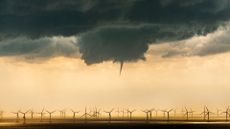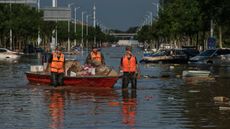Germany floods: what led to this ‘once-in-a-century’ disaster?
Nearly 200 people died in Germany and Belgium; hundreds are still unaccounted for

Early last week, a low-pressure system began forming over the area where Germany meets Belgium, Luxembourg and the Netherlands, said The Economist. Puffed up by heat –in the Netherlands, it had been the hottest June since 1901– it sucked in moisture from all across central Europe. “Then it sat there for days, disgorging colossal quantities of rain.”
Some regions got over 90mm of precipitation last Tuesday – much more than the average amount for a month – and a further 70mm or more the next day. “Soon entire towns were under water.”
Across Germany’s northwestern states, houses, bridges and cars were swept away. Villages were destroyed. The press called it a Jahrhundertflut, a once-in-a-century flood: the worst in postwar history. Nearly 200 people died in Germany and Belgium; hundreds are still unaccounted for. Even the Netherlands, with its famous system of dykes and canals, suffered heavy damage. On a visit to Rhineland-Palatinate state, Chancellor Angela Merkel said: “The German language has no words, I think, for the devastation.”
Subscribe to The Week
Escape your echo chamber. Get the facts behind the news, plus analysis from multiple perspectives.

Sign up for The Week's Free Newsletters
From our morning news briefing to a weekly Good News Newsletter, get the best of The Week delivered directly to your inbox.
From our morning news briefing to a weekly Good News Newsletter, get the best of The Week delivered directly to your inbox.
German politicians were quick to blame the flooding on global warming. While experts say that climate change is never the direct cause of a flood, “it affects the likelihood and frequency of them occurring, and their intensity”, said Tom Parfitt in The Times.
“More and more cases of extreme weather” are predicted as the global temperature rises. Looking around the world – at the floods in Germany, the heatwaves in the US, the wildfires tearing through Siberia’s forests – it is hard not to conclude that we are at the start of a climate emergency.
New “rapid attribution studies” allow the role of climate change in such events to be quickly assessed. One such study found that last month’s fatal heatwave in the Pacific Northwest of the US and Canada would have been “virtually impossible without human-caused climate change”.
This is an election year in Germany, and the campaign is likely to be shaped by the worst natural disaster in its recent history, said Der Spiegel. Harsh though it may sound, the floods probably “play to the Greens’ advantage”: they are already second in the polls, despite a difficult campaign.
The floods also pose problems for Armin Laschet, the candidate for Merkel’s CDU. As governor of the badly-affected North Rhine-Westphalia state, he is in the firing line. He was criticised for seeming to laugh during a visit; he also brushed off questions about his climate policies, saying: “You don’t change your policies just because of a day like this.” Those words may come back to haunt him. “In such moments of need, people often take a closer look at the people in power than they normally would.”
Create an account with the same email registered to your subscription to unlock access.
Sign up for Today's Best Articles in your inbox
A free daily email with the biggest news stories of the day – and the best features from TheWeek.com
-
 Who actually needs life insurance?
Who actually needs life insurance?The Explainer If you have kids or are worried about passing on debt, the added security may be worth it
By Becca Stanek, The Week US Published
-
 Sexual wellness trends to know, from products and therapies to retreats and hotels
Sexual wellness trends to know, from products and therapies to retreats and hotelsThe Week Recommends Talking about pleasure and sexual health is becoming less taboo
By Theara Coleman, The Week US Published
-
 Is the AI bubble deflating?
Is the AI bubble deflating?Today's Big Question Growing skepticism and high costs prompt reconsideration
By Joel Mathis, The Week US Published
-
 What can Cop28 really achieve?
What can Cop28 really achieve?Today's Big Question Climate summit in UAE proves controversial as UN warns world is falling short of global warming targets
By The Week UK Published
-
 The drying Amazon rainforest: a drought that affects the world
The drying Amazon rainforest: a drought that affects the worldUnder the radar The Amazon is suffering a drought of historic severity and it’s pushing its inhabitants to their limit
By The Week UK Published
-
 Rosebank oil field: pragmatism over future prospects?
Rosebank oil field: pragmatism over future prospects?Talking Point Green campaigners decry 'morally obscene' opening of new oil fields while trying to cut emissions
By The Week Staff Published
-
 Libya: the 'tsunami' that washed away a city
Libya: the 'tsunami' that washed away a cityTalking Point Climate change may have made the storm more likely, but many blame failures of governance for the scale of the tragedy
By The Week Staff Published
-
 Offshore wind: a blow to UK policy
Offshore wind: a blow to UK policyTalking Point Britain's failed offshore wind auction debacle 'highlights an inconvenient truth'
By The Week Staff Published
-
 Tackling climate change: is China laggard or pioneer?
Tackling climate change: is China laggard or pioneer?feature Beijing remains reticent to publicly debate climate change which is consistently downplayed as a cause of recent disasters
By The Week Staff Published
-
 The hottest July: America’s Southwest boils in the heat
The hottest July: America’s Southwest boils in the heatfeature Phoenix residents have suffered burns after falling on the city’s scalding roads
By The Week Staff Published
-
 The green arms race explained
The green arms race explainedfeature Massive US subsidies for green technology are causing major shifts in the world economy
By The Week Staff Published